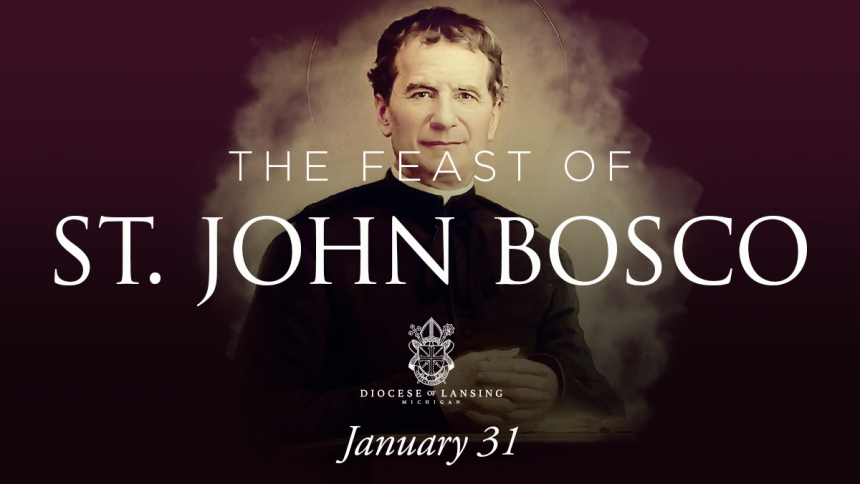
Today is the Feast of Saint John Bosco (1815 – 1888), the Italian priest who was particularly renowned for educating disadvantaged boys in industrial Turin using teaching methods based on love rather than punishment.
So, what can we learn from Saint John when it comes to drawing our young people closer to Christ. Here’s three tips as discerned by Brian Flynn, the Diocese of Lansing’s Director of Parish Youth Discipleship. Brian writes:
It’s funny; in my experience in both youth ministry and catechesis over the last 25 years I have heard many youth ministers claim the patronage of St. John Bosco. Likewise, I have heard still others assign his patronage to catechists and teachers. According to the canon of saints and their acknowledged patronages, neither of these is true. For youth ministers that patronage goes to St. Aloysius Gonzaga (although many other saints and blesseds are often invoked in youth ministry, such as Pope St. John Paul II, St. Therese of Lisieux, Bl. Pier Giorgio Frassati, Bl. Chiara Badano and Bl. Carlo Acutis.) As far as catechists are concerned, that patronage goes to Saints Charles Borromeo and Robert Bellarmine. Of course, saints are saints, and the Church doesn’t prohibit us from praying to whichever saints we have a devotion to or whose patronage we seek.
Why is St. John Bosco so often invoked when it comes to discipling young people? St. John Bosco is patron saint of youth and of students, among other things. This means that whatever context we find ourselves in whether the classroom, the youth room, the home, or the streets, we can emulate much of his approach in discipling young people. Following are three lessons that if we apply, will help us to be more effective.
1. The Right to be Heard: St. John Bosco ministered to the youth of Turin, Italy in the mid-1800s. At the time Turin was a heavily industrial city. He had a particularly strong vocation to minister to the many young boys who lived in the city. From his time ministering to those in prison, he witnessed firsthand how many young boys were ending up incarcerated. He made it part of his mission to help the boys on the streets to grow in virtue and to stay out of trouble. To succeed in this, he met them where they were. He went to the streets, to the factories and farms. He learned about the realities of their lives, and having earned the right to be heard, was able to minister to those realities.
• Modern-day tip: Get out of the classroom and off the church campus and meet the youth where they are; at their schools, their workplaces, their activities and in the context of their families. Earn the right to be heard.
2. Formative: St. John Bosco didn’t just hang out with the youth on the streets, playing ball as he is sometimes depicted. Once he developed relationships with youth, he began catechizing them and mentoring them in the Faith. He even guided some of them into seminary formation for the priesthood. Furthermore, he didn’t only teach the youth in a formal way, but spoke to their deepest realities, their dignity. He helped these young people to learn the trades and other skills relevant to their lives so they could reach their God-given potential, avoid a life of poverty and crime, and grow in virtue along the way. In this way the young people in his care could make sense of the catechetical components because he showed them how to apply to their daily lives.
• Modern-day tip: Be sure not to avoid forming young people in the areas of their Faith that apply most directly to their current state in life. Our youth are yearning to know how to apply their Faith to their lived realities, which are sometimes messy and complicated. Avoiding those areas that are controversial or awkward won’t help them to engage those situations or issues through the lens of Faith. Be bold and courageous in order to form well.
3. Personal: In addition to meeting and interacting with large groups of teens, St. John was also intentional about ministering one on one or in smaller groups. He knew that each young person had their own needs and realities that would best be ministered to individually, personally. It is said that he combines the catechetical formation with fatherly guidance. In this way he was able to minister to body and soul, the whole person and to help each individual know that he cared for them.
• Modern-day tip: Find time and creative ways to have one on one conversations with the youth in your communities. Even if part of a larger gathering, make time to ask questions, to listen and then respond to their needs and questions. If individual conversations prove difficult, implement a small group discipleship model where there could be 6-10 participants in each group. In a small group model each participant is given more time to share what is going on in their lives, and the group leaders are able to respond and speak into those areas with more intentionality than in a large group. This practice is more personal than a large group setting. People can get lost in a large group setting and feel like they aren’t important. In individual or small group settings, there are more opportunities to apply the approaches of St. John Bosco, and to hopefully achieve similar results.
St. John Bosco, Pray for Us!
